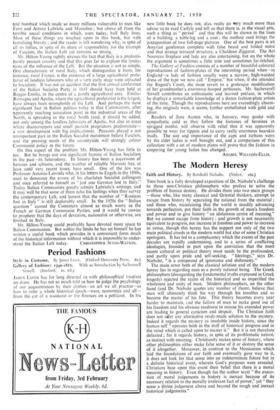Period Fashions
Style in Costume. By James Laver. (Oxford University Press. 6s.) Gallery of Fashion: 1790-1822. With an Introduction by Sacheverell
Sitwell. (Batsford. 6s. 6d.) JAMES LAVER has for long diverted us with philosophical treatises on di ess. He has not so much told us how to judge the psychology of our acquaintances by their clothesŌĆöan art we all practiseŌĆöas how to infer a whole historical epochŌĆöwars, economics and allŌĆö from the cut of a waistcoat or the flounces on a petticoat. In his new little book he does not, alas, really do very much more than advise us to read Carlyle and tell us that there is, in the visual arts, such a thing as " period " and that this will be shown in the lines of a building, a table-leg and a coat ; the method used brings the juxtaposition of two full-page pictures One of the best pairs is an Assyrian gentleman complete with false beard and folded mitre and that strange terraced structure, a Chaldean Ziggurat. The Art Nouveau fireplace and lady are also entertaining, but on the whole the argument is sometimes a little trite and sometimes far-fetched.
The Gallery of Fashion consists of a number of beautiful coloured reproductions of fashion-plates of the interesting period whenŌĆöin EnglandŌĆöa lady of fashion usually wore a narrow, high-waisted dress of the type we now call "Empire," but when, if she attended the Regent's Court, she must revert to a grotesque modification of her grandmother's enormous hooped petticoats. Mr. Sacheverell Sitwell contributes an enthusiastic and learned preface, in which he displays a remarkable knowledge of a dozen fashion-plate artists of the time. Though the reproductions here are exceedingly charm- ing, the originals were, it seems, further embellished with gold and silver.
Readers of Jane Austen who, in January, may quake with sympathetic cold as they follow the fortunes of heroines in sprigged muslin, will observe with relief that it was apparently possible to wear fur tippets and to carry really enormous bearskin muffs. The size and importance of the caps and turbans worn by the elder ladies is well brought out, and a comparison of this collection with a set of modern plates will prove that the fashion in simpering for young ladies has changed.
AMABEL Wituams-Ews.










































 Previous page
Previous page